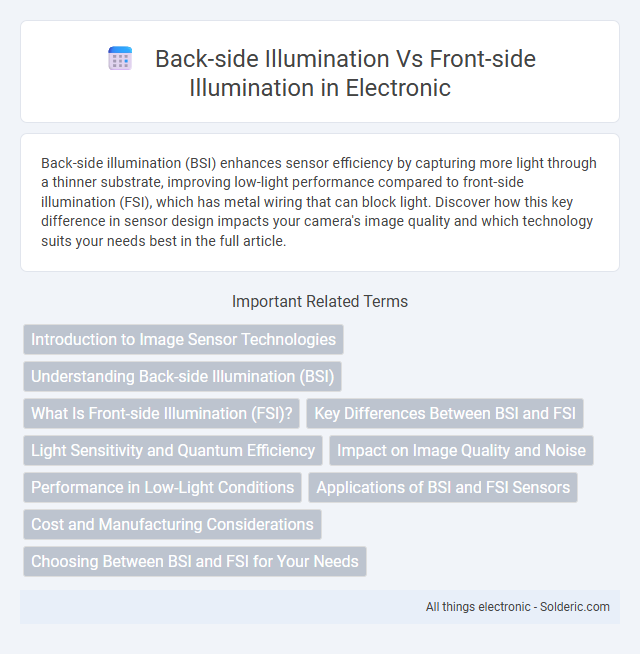Back-side illumination (BSI) enhances sensor efficiency by capturing more light through a thinner substrate, improving low-light performance compared to front-side illumination (FSI), which has metal wiring that can block light. Discover how this key difference in sensor design impacts your camera's image quality and which technology suits your needs best in the full article.
Comparison Table
| Feature | Back-side Illumination (BSI) | Front-side Illumination (FSI) |
|---|---|---|
| Sensor Structure | Light enters from the back, avoiding wiring layer | Light passes through wiring layer before reaching sensor |
| Light Sensitivity | Higher sensitivity, better low-light performance | Lower sensitivity, limited low-light capability |
| Noise Level | Reduced noise due to improved light capture | Higher noise due to light obstruction by wiring |
| Manufacturing Complexity | More complex and costly fabrication process | Simpler and less expensive manufacturing |
| Applications | Smartphones, low-light cameras, advanced imaging | Basic digital cameras, older imaging devices |
Introduction to Image Sensor Technologies
Back-side Illumination (BSI) and Front-side Illumination (FSI) are two principal image sensor architectures used in digital cameras to enhance light capture efficiency. BSI sensors position the photodiodes closer to the light source by flipping the sensor's structure, significantly improving low-light performance and image quality compared to traditional FSI sensors where wiring and metal layers partially block incoming light. Advances in BSI technology have enabled higher pixel densities and better noise control, making it the preferred choice for modern smartphone cameras and compact imaging devices.
Understanding Back-side Illumination (BSI)
Back-side Illumination (BSI) technology enhances image sensor performance by repositioning the wiring layer behind the photodiode, allowing more light to reach the sensor. This design improves low-light sensitivity and reduces noise compared to Front-side Illumination (FSI), where wiring obstructs incoming light. BSI sensors are widely used in smartphones and digital cameras to capture clearer, brighter images in challenging lighting conditions.
What Is Front-side Illumination (FSI)?
Front-side illumination (FSI) is a sensor technology used in digital cameras where the light passes through the metal wiring and transistors on the front of the image sensor before reaching the photodiodes. This configuration can reduce the amount of light captured, leading to lower sensitivity and performance in low-light conditions compared to back-side illumination (BSI) sensors. FSI sensors are typically less expensive to manufacture but may suffer from higher noise and reduced image quality in challenging lighting environments.
Key Differences Between BSI and FSI
Back-side Illumination (BSI) sensors position the photodiode closer to the light source by flipping the sensor structure, enhancing light absorption and improving low-light performance compared to Front-side Illumination (FSI) sensors where metal wiring obstructs light. BSI sensors offer higher quantum efficiency and reduced noise due to minimized light blockage, resulting in better image quality, especially in smartphones and compact cameras. In contrast, FSI sensors tend to have lower manufacturing costs but suffer from reduced sensitivity and increased pixel size constraints.
Light Sensitivity and Quantum Efficiency
Back-side Illumination (BSI) sensors offer superior light sensitivity compared to Front-side Illumination (FSI) sensors by positioning photodiodes closer to the light source, minimizing photon loss caused by metal wiring and circuitry. This design enhances quantum efficiency, enabling BSI sensors to capture more photons per unit of light, resulting in clearer and brighter images, especially in low-light conditions. Your choice of sensor directly impacts image quality, with BSI technology providing a significant advantage when maximizing light capture and sensor performance is critical.
Impact on Image Quality and Noise
Back-side Illumination (BSI) sensors improve image quality by allowing more light to reach the photodiodes, reducing noise and enhancing low-light performance compared to Front-side Illumination (FSI) sensors. BSI sensors minimize the obstruction caused by wiring layers, increasing quantum efficiency and resulting in sharper images with better color accuracy. FSI sensors typically exhibit higher noise levels and reduced sensitivity, especially in challenging lighting conditions, due to less efficient light capture.
Performance in Low-Light Conditions
Back-side illumination (BSI) sensors significantly enhance performance in low-light conditions by capturing more light through an optimized pixel design that places the photodiode closer to the light source, reducing signal loss. Front-side illumination (FSI) sensors, with circuitry positioned above the photodiode, tend to scatter more light and reduce sensitivity, impairing image quality in dim environments. Your choice of a BSI sensor will result in clearer, brighter images with improved noise reduction when shooting in challenging low-light scenarios.
Applications of BSI and FSI Sensors
Back-side Illumination (BSI) sensors excel in low-light photography and smartphone cameras due to their enhanced light-gathering efficiency, making them ideal for applications requiring high sensitivity and improved image quality. Front-side Illumination (FSI) sensors are commonly used in applications where cost and manufacturing simplicity are prioritized, such as in basic digital cameras and industrial imaging systems. Your choice between BSI and FSI sensors depends on the need for advanced imaging performance or cost-effective solutions in specific devices.
Cost and Manufacturing Considerations
Back-side Illumination (BSI) sensors generally incur higher manufacturing costs due to the complex wafer thinning and backside processing required, which increases production time and equipment investment. Front-side Illumination (FSI) sensors benefit from a mature, less expensive fabrication process but often sacrifice efficiency and low-light performance, which can impact overall sensor value. You should weigh the enhanced image quality of BSI against its higher cost when choosing the sensor type for your application.
Choosing Between BSI and FSI for Your Needs
Back-side Illumination (BSI) sensors offer higher light sensitivity and better low-light performance than Front-side Illumination (FSI) sensors, making them ideal for smartphones and compact cameras. FSI sensors, while typically more affordable, suffer from light obstruction caused by wiring layers, reducing efficiency in dim settings. You should choose BSI if your priority is superior image quality in low-light environments, whereas FSI can be suitable for budget-friendly, well-lit applications.
Back-side Illumination vs Front-side Illumination Infographic

 solderic.com
solderic.com